 |
|
Scouting With a
Neckerchief
BY
COMMODORE W. E. Longfellow
AMERICAN RED CROSS LIFE SAVING
SERVICE, VETERAN SCOUT, MEMBER OF NATIONAL SEA SCOUT COMMITTEE
AND NATIONAL COUNCIL, BOY SCOUTS OF AMERICA
The Boy Scout Service Library,
Series B, No. 6, Boy Scouts of America, 1927
|
WITHIN the past five years
the woodland tan of the Scout Uniform has been brightened by the
addition of the colorful Scout kerchief, which is now regarded as an
indispensable article of equipment for every member of the Boy Scouts of
America. It is more than a part of the Scout Uniform; it is actually one
of the most useful items of a Scout's equipment.
More than sixty distinct
uses have been developed for this characteristic and distinctive touch
of color which has completed the outfit of the Boy Scout in America and
made him one of the most picturesque figures in our national life.
The Scouts of Old
After all, the Scout of
today is the legitimate heir to this bright and distinctive neckerchief
which was worn by the scouts of old. The buckskin scout was obliged to
dress in sober hues that would blend with the leafy coloring of the
woods, the dead leaves and the earth itself. He could not afford several
suits of clothes, and a new suit of buckskin was a great event in his
life—not because of the difficulty in killing deer for the purpose,
because that was comparatively easy, but for the trouble it was to make
up a suit. Tailor shops were not common in the wilderness of those days,
neither were there skilled craftsmen with the needle who could work the
buckskin into a serviceable garment, so one suit of clothes had to do a
long time.
Whatever his love of bright
color, the woods-running scout was a hunter of animals, or birds, or
men, who was in turn hunted by his enemies, and so was obliged to forego
this color while in the forest. The less conspicuous his garb, the
better bag of game and the safer his hair rested upon his head. But when
he came to a settlement, seeking relaxation, there was no need for
restraint in the matter of color, and so, by means of a crimson scarf to
tie his long hair, or a purple or blue sash, he was able to satisfy this
yearning for bright things.
On those occasions when a
woods runner was visiting a settlement wearing his bright scarf, it was
quite clear that he was resting from the trail and seeking relaxation;
he was wearing his best and was on parade, willing to be reviewed by the
finest people in town. On the trail, his scarf or kerchief took up but
little room in his meager bag; moreover, in case of a wound it had great
possibilities. The Scout of today is heir to the many worth-while things
of that earlier forest runner who could shift for himself under the most
difficult circumstances.
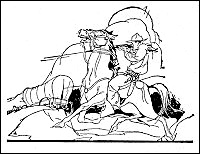
Plains Scouts
In later days, when it
became necessary to settle the great plains and blaze the trails for the
railroad, the telegraph and the broad highroads of today, a sturdy breed
of plains scouts came into existence to guide and guard the workers and
hunt and trap for them to provide food. These plains scouts rode
horseback, and as their ponies kicked up the sand and dust, some of it
filled with alkali, it made breathing difficult, so that in defense they
wore around their necks a broad kerchief. Whatever the color of their
work-a-day kerchiefs, and however drab they might be if Indian wars were
under way, even the poorest of them could carry a bright red, blue,
green or yellow scarf for dress up occasions. So from this scout too
today we inherit the bright neckerchief.
Neckerchief Uses
In those days these
neckerchiefs were worn with the broad point to the front and were
loosely knotted behind the head, thus it was possible, in case the dust
became very bad, to tighten it over the mouth and nose and use it as a
filter against the dust and as a protection against the blinding sand
storms which sometimes bothered travelers on the wide expanses of the
great western basins.
To be sure, many of the
lawless bandits that infested the plains in those perilous times used
the neckerchief as a facial disguise, and it proved effective because
most men looked alike as to their outer garments, with wide felt hats
flannel shirts and overalls or "chaps" of the plains rider.
So the Scout of today uses
his neckerchief soaked in water to filter the fire from heat-laden air
and to cool smoke when entering a burning building as he crawls along
the floor in the only strata of fresh air left. The Scout of today knows
that it is not a gas mask, but merely a smoke screen and filter.
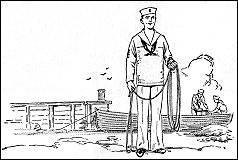
The Man O'Warsmen of old
originally wore the neckerchief as a mourning badge after the death of
Lord Nelson. This British Naval hero was revered on both sides of the
water, and by the time the American Navy was separated from the British
Navy and in conflict with it, it was natural enough to continue to use
this folded square of black silk as a part of the sea-going uniform of
the mariner fighting under orders of the Continental Congress.
Made as it is of tough silk
of very light weight, this kerchief has been found to be of great value
as a first aid appliance to stop hemorrhage, sling a fractured arm or
bind up a broken head. And so its continued use in the modern Naval
uniform has the support of both tradition and custom, and of the medical
authorities who see in it a first aid appliance of the very highest
emergency and greatest utility.
In view of these facts, it
is clearly no exaggeration to say that the neckerchief is one of the
most characteristic and distinctive parts of the uniform of a Scout. It
identifies he district to which he belongs; by the knot in the . end l t
reminds him of his Daily Good Turn; it reminds him that he is a Scout
with traditions to sustain, and every time he adjusts it on his neck he
is challenged to devise more and better uses for it.
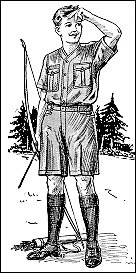
The Scout's
Neckerchief
Up to about 1915 the
neckerchief was not generally recognized as a necessary part of the
Scout equipment, and a I number of Scout enthusiasts were asked for
ideas on I possible uses of the neckerchief. I was already much in favor
of it and could think of as many as eighteen Scout I uses for it at that
time. This appeared to be about twelve I more than anybody else could
think of, so I was selected to I write an article on the neckerchief,
and by the time I completed it I developed some twenty-eight uses. These
soon I grew to thirty, and now we have more than sixty uses to I
recommend to Scouts the world over. Whole Scout demonstrations can be
given with the help of the neckerchiefs I worn by members of the Troop,
but after al], the best demonstration is the actual utility, and we will
endeavor to confine our description to the actual rather than the
theoretical uses of the neckerchief.
How to Wear It
Here is the proper way for
a Scout to fold and wear his neckerchief.
First, fold the neckerchief
once to get the triangle. According to the size of the boy, turn the
long edge over about three inches, smoothly once or twice, or even three
times, to insure the neckerchief lying smoothly at the back and hanging
correctly in front.
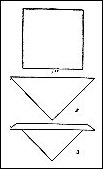 |
|
Method
of folding the Scout Neckerchief.
the number of cross-folds--if any--governed
by the size of the Scout, in order to assure
smooth set at back. The half-neckerchief,
when used, takes the same folds. |
Place around the neck over
the collar of the shirt, insert the slide up over the ends to the point
where the knot would be if tied as a four-in-hand necktie. Then tie the
two loose ends in an overhand knot, as if it were one piece of material.
This lower knot is a constant reminder of the Daily Good Turn.
 |
|
The
correct form in wearing the Scout
Neckerchief, with Turk's head slip-on and
Good Turn knot. |
Why the Slide
The advantages of the slide
are that in hot weather and on the hike the neckerchief can be loosened
around the throat while in a cold wind or snowstorm it can he drawn up
closer to serve as a muffler. When necessary to use the neckerchief in
emergencies, the slide can be instantly drawn down, permitting the
neckerchief to be whipped off over the head. When the slide is not used
a knot must be tied, and it is seldom tied twice alike nor at the same
position at the throat, a very untidy appearance resulting. The slide is
an immense convenience and adds distinctly to the appearance of the
neckerchief.
 |
| Slip-ons
made from wood or bone |
How Sea Scouts Wear
Them
It will be noted that the
Sea Scout method of wearing the neckerchief differs from the method used
in shore Scouting. The sea-going Scout will prepare his kerchief as do
the sailors in the Navy, finishing with a flat knot on the tails. This
type of neckerchief does not look well unless covered by a wide collar;
consequently it is not used with the khaki uniform but only with the
sailor collar.
In connection with the
preparation of your own Turk's head knot for a home-made slip-on, the
Sea Scout Manual gives a description of the way to make a Turk's head,
as follows:

Three Stranded
Turk's Head
Take two round turns around
the rope on which you intend working the knot, or around the index
finger of your left hand. Pass the upper bight down through the lower,
and reeve the upper end down through it; then pass the bight up again,
and reeve the end over the lower bight and up between it and the upper
one; dip the upper down through the lower bight again, reeve the end
down over what is now the upper bight, and between it and the lower; and
so proceed, working round to your right until you meet the other end
when you pass through the same bight and follow the other end round and
round until you have completed a plait of two, three or more lays, along
the three strands of the Turk's head.
Wearing It Right
James E. West, Chief Scout
Executive, says: "We are anxious to have the co-operation of every
Scout and Scout Official in making effective the regulations covering
the Official Uniform, Insignia and Badges. To tolerate a conscious
disregard for requirements, even in simple matters, breeds disrespect
for law and order. When I have found boys wearing the neckerchief under
instead of over the shirt collar, it developed that invariably the
Scouts, and indeed their own Scoutmaster, did not understand the correct
way of wearing the neckerchief. I am anxious that every Scout and Scout
Official study the diagram, wear the neckerchief in the right way, and
that he invite the attention of other fellows to the right way when he
finds them wearing it wrong."
Colors
The color of the
neckerchief indicates the Troop, District or Council, according to the
local regulations. Scout neckerchiefs should always be worn with a
contrasting slide which in appearance resembles the Turk's head knot and
serves as a reminder of the Scout's Daily Good Turn pledge. The main
reason that this slide is used rather than a knot is that it permits the
neckerchief's instant removal if needed in an emergency. Slides are
furnished by Headquarters in a variety of colors, and when once adopted,
each Troop should stick to the color and have it worn by all members.
There are many varieties of slides, however, and characteristic slides
are often used, such as the Kukui nut in Hawaii, and the Horn slide or
sheep vertebra slide of the western plains.
Practically all of the uses
of the neckerchief are because of its triangular form, so that a
triangular bandage can be used for practice, thus saving the official
color kerchief so that it makes a good appearance on the uniform. It
should be borne in mind, however, that the Official Neckerchief is
slightly smaller in size than the regulation triangular bandage which is
made by splitting a yard of cloth, crosswise.
Neckerchief
Duplicates for First Aid Practice
In order to be sure that
the rehearsed uses of the neckerchief are applicable to the regulation
scarf, it might be well to make a duplicate of the regulation scarf in
white cotton cloth of the exact Scout dimensions—28 x 32 in.—and use
it for all practice purposes. I have been able to purchase unbleached
sheeting as low as 14 and 16 cents a yard, of sufficiently durable
weight for this purpose. You may find that prices are higher, but in
practically any part of the country one should be able to purchase
unbleached sheeting for less than 20 cents a yard for the purpose of
making practice equipment.

LET us consider first the
number of distinctly Scout uses to which the kerchief can be put.
(Numbers
refer to the list at the end of this article)
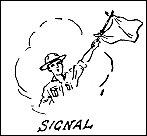
It is natural to think of
it as a signal flag (1) a brightly colored kerchief can be attached to a
staff, walking stick or canoe paddle, with string or by knotting itself,
and used to send Morse code a considerable distance. With two white
kerchiefs against a dark background, practice as well as actual sending
of messages by the Semaphore code (2) can be done effectively. With
practice, a maximum amount of the material can be shown to catch the eye
of l he receiver.
Another distinct utility
for a Troop meeting is knot-tying practice (3), after the neckerchief
has been folded to triangular shape and then down to narrow cravat form.
It is especially handy for teaching the square knot and for practice in
this and in tripping the knot by upsetting it. This can be done by
pulling the tail end of one side of the knot away from the standing part
to which it belongs; this trips or upsets the square knot, which can be
stripped free by encircling the standing part with the fingers and
sliding it off the end.
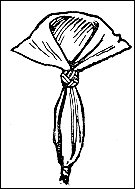
The proper wearing of the
neckerchief is useful for Troop and Patrol identification (4), and a
single knot in the point (5) is a "Good Turn" reminder,
although the slide is sometimes called this. The wearing of the
neckerchief (6) is in itself an indication that the wearer is not a
cadet but a Scout.

Properly folded, from wide
to narrow cravat, the neckerchief may be tied in a square or surgeon's
knot as a substitute for a belt (7), and hung over the shoulder and tied
under the arm it furnishes a shoulder mat (8) for wall scaling or for
carrying timbers or pipe in such a way as to save the uniform from
staining or save weight from chafing.
 |
|
Shoulder mat for
wall scaling
|
In working out problems of
rescue, the entire Troop can be directed to put on the wide cravat form
of the neckerchief as a smoke mask (9), covering the nose and mouth and
hanging below the chin. To simulate crawling into a smoke-filled room,
the triangular bandage can be folded over the eyes of the Scout rescuer
and tied in the back in order that his rescue work can be done entirely
by feeling—so we have the blindfold for Scout games (10). Another form
of this blindfold can be made by tying a knot in the broad point, which
is put over the top of the head; the ends are folded around the neck,
crossed in back and tied in front under the chin. This leaves the loose
part of the neckerchief over the face, effectively covering the eyes,
and is a dressing used in first aid for a burned face and neck, (11).

During the period for Scout
games, the neckerchief can be used as a sweat band (12), confining the
hair in place for such games; and contesting teams can be identified in
two ways—either by neckerchiefs of different colors (if from different
districts ), or by wearing the neckerchiefs in a different place if from
the same district (13). These different methods of wearing the
neckerchief would include: around the forehead, cowboy fashion, with the
broad part in front of the neck, Scout fashion, broad part in back, as a
shoulder sash, right or left shoulder; and on the right or left arm
between the biceps and shoulder.
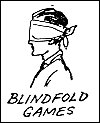
In games, such as running
the gauntlet, the folded neckerchiefs held by the two ends make swatters
(14) which are not dangerous; if held by one end there is a whip lash
effect which might be dangerous if flicked into the eye or face. The
neckerchief also has a value in the three-legged race (15), where it can
be used to tie the runners together, and in a cockfight, or other race
requiring the contestants to be hobbled (16), it serves very well to tie
the wrists or ankles together. In this same way it could be used to
hobble a horse by reducing the freedom of his legs, so that he could
graze without being able to run or jump. This is sometimes used on the
plains.
There is another Scout game
called badger pulling, in which two boys on hands and knees with heads
close together have a rope or belt slipped over their heads behind the
ears, and try to pull each other across a center line by backing up. Two
neckerchiefs would serve for confining the "badgers" (17) if
not tied too near to the end.
Use Around Camp
The neckerchief can be used
as a night cap or ear protector (18), and this sort of cap would also
serve as an identification in games. By tying the broad point of the
triangle a sort of hood is made, just the reverse of the blindfold hood,
and the ends are tied under the chin. This is excellent for protection
against mosquitoes while hiking through woods and brush. Scouts should
also be required to make the neckerchief into a muffler for storm or
blizzard protection, which would form the 19th use for general purposes.
There are also a number of
uses which can be made of the neckerchief around water. One of these is
the covering of a pail to serve as a filter for muddy or oily water
(20). It could also serve as a loin cloth or bathing trunks for an
unexpected dip in a not too secluded stream (21).
By putting the broad center
of the kerchief to the forehead, letting the point fall toward the back
of the head and using the ends crossed in the back and tied in the
front, the usual triangular cap bandage is formed (22). This, used with
red kerchiefs, identifies the non swimmers; blue kerchiefs the beginners
who can swim fifty feet or more, and white kerchiefs the free swimmers
who can swim more than 100 yards.
While working around a camp
fire the neckerchief may become a napkin (23) to keep the shirt front
clean, for it is easier to wash a neckerchief than a shirt. It may
become an apron (24) for kitchen police duty, for it is easier to wash a
neckerchief than a pair of Scout breeches. Several kerchiefs may be used
as a table cloth (25) to keep the food off the ground, and it may be
used as a dust cloth or cover (26) to keep dust, leaves and flies out of
opened food which has been prepared for the meal.

A very handy use for the
kerchief is the hobo bag (27) made by tying the opposite points
together, thus making a receptacle large enough to carry about half a
peck of apples, potatoes or other vegetables purchased from a nearby
farm.
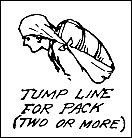
On the trail the kerchief
or triangular bandage may be made into a tump line (28), which is worn
around the forehead and fastened to a pack to ease the strain on the
shoulder straps for a long portage. The head is not used as the main
carrying force but as an auxiliary for the relief of the shoulder.
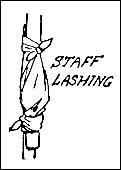
Similarly the neckerchief
may be used to lash poles or staves together (29). On a long canoe trip
I had a lot of trouble with a canoe which had no keel; it steered badly
and could not keep up, so we lashed poles across which kept the boats
two feet apart amidships. This made it necessary for us to paddle only
on the outside, and with the working neckerchiefs there is a good
holding surface and they are easily unfastened when it is necessary to
make a portage around a dam or waterfall.
A little handful of fire
and a neckerchief will make a smoke signal (30) and will enable Scouts
to practice short-distance signaling by puffs of smoke, as they would do
on long distance with a blanket and a larger smoky fire. (Information on
making smoke signals can be-found in the Scout Hand Book and in books on
Indian lore.)
On occasions when carrying
a new flag pole to camp or having tent poles projecting behind the
touring car or truck, safety regulations require a red flag hung on the
projecting end. (Use 31).
Boat Uses
Likewise, a piece of a
neckerchief well covered with pitch) or white lead would make a patch
for a canoe (32), or, shredded into strips, would make caulking for a
leaky. boat (33) when shoved into the open seams with a pocket: or table
knife.
If marooned on a broken
down motor boat or canoe outboard motor, the neckerchief would probably
be the least expensive and most effective thing to sacrifice to make a
flare (34) — wadded into a ball, saturated with gasoline and lighted,
while protected by a mess kit or tin cup. In this case, the neckerchief
would serve as wicking and would make the flame last longer than a match
or paper. Kerosene, or even cooking grease, would burn similarly if no
gasoline were available. The burning of a flare is a distress signal
recognized by boatmen the world over.
In making a portage from
one lake to another, some Scouts will find it easier to carry loads on
their heads. A folded neckerchief or a neckerchief rolled into a thick
bundle, can be carried on top of the head to serve as padding (35). It
might also be used to prevent chafing wherever heavy weights come —
either on the shoulder or in the palm of the hand, where it may be used
as a glove (36) to prevent blisters.
Use on Horses in
Emergency
Any Scout who has ever been
in a burning stable realizes the difficulty in getting horses to go out
through the dark doorway. The light confuses them, so it is necessary to
blindfold the horse. A neckerchief tied over the horse's eyes will serve
admirably for this purpose (36) and will be found large enough.
Similarly, Scouts who are fortunate enough to go hiking on horseback or
with a baggage wagon may find it necessary to pad portions of the
harness to prevent saddle or harness galls. A neckerchief would serve
the purpose in these emergencies (37).
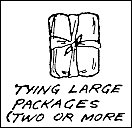
Groups of Scouts who are
living in movable camps will find that in packing up each day for
loading canoe, truck, car, pack horse, etc., there will be numberless
bundles to be tied up. In the wilds there is seldom enough rope, so that
the neckerchief folded into a narrow cravat form is excellent to tie up
square packages, two of the neckerchiefs being usually required for an
ordinary flat bundle (38). In making the blanket roll— famous in the
Spanish American War — the ends of the roll may be fastened together
with a neckerchief if no straps or rope is available (39); it is not
beautiful, but it is effective. This is the horse-collar pack, which is
also used with the official haversack recommended by the Scout Supply
Department.
For Group Work
There are a number of
distinct uses of the kerchief requiring the cooperation of several
persons. Among these are the Life Line, or Guard Rope (40); the Rope
Ladder for rescue from a well (41); the Boat Sail (42) and the Emergency
Clothing (43).
To make the life line and
rope ladder, a sort of drill can be developed so that it can be done
smoothly. The Scout should be cautioned to tie the ends at least six
inches from the tip, so that the stronger part of the cloth may be used
and undue strain will not be put on a very narrow area, thus
jeopardizing the safety of the person who is being rescued.
The Troop should be
directed: "Prepare to form a life line. Fall in in single file.
Remove neckerchiefs. Connect neckerchiefs from the right. Tie off
neckerchiefs." At this last command, every one from the right of
the line ties his neckerchief to the end of the next neckerchief, using
a square knot, the last person in line being the only one who does not
have to tie. The next command would be: "Patrol leaders inspect
knots." A Troop of thirty Scouts would give a life line 70 or 80
feet long with which to get a person out of the water, ice, or to be
used as a guard rope.
For a rope ladder the
commands would be: "Prepare to make a rope ladder. Fall in single
file. Count three. Ones and twos link neckerchiefs and tie off."
(The broad parts of the neckerchiefs are looped together and tied with a
square knot so that each one is a complete circle.) "Number threes
connect links." Each number three then loops his neckerchief
through the links of the chain made by number two to his left and number
one to his right, and ties.
As a Sail
The construction of a boat
sail and the emergency clothing are similarly done. The corners of two
or three kerchiefs are tied together, then the next row is knotted to it
to make the strip wider, the middle knots being interlocked.
Considerable sail surface could be secured with four or six
neckerchiefs, but it would be a poor substitute for clothing—rather
drafty to say the least. If there are pins available in the first aid
kit, a very much better job could be done in dressing the fellow whose
clothes were lost—and this is, of course, a comedy stunt rather than}
anything to inspire serious thought among spectators.
Summary of Uses for
the Scout Neckerchief
The Scout Neckerchief may
be used:
1. As an International
Morse signal flag.
2. For sending messages by Semaphore code.
3. In knot-tying practice.
4. For Troop and Patrol identification.
5. As a reminder of the Scout Good Turn, (single knot).
6. As indication that wearer is not a Cadet, but a Scout.
7. As a substitute for a belt.
8. As a shoulder mat.
9. As a smoke mask.
10. As a blindfold for Scout games.
11. As a dressing for a burned face and neck.
12. As a sweat band for confining the hair.
13. For identifying contesting teams.
14. As a swatter in playing games.
15. In the three-legged race, to tie legs together.
16. In games requiring contestants to be hobbled.
17. In game called "Badger Pulling," to make binder for heads.
18. As a night cap or ear protector.
19. As a muffler for storm or blizzard.
20. As a cover for a pail of water.
21. As a loin cloth or bathing trunks.
22. As a triangular cap bandage.
23. As a napkin.
24. As an apron.
25. As a table cloth.
26. As a dust cloth or cover.
27. As a "Hobo" bag.
28. For a tump line to carry a load.
29. To lash poles or staves together.
30. As a smoke signal.
31. As a red flag on projecting end of load.
32. As a patch for a canoe, when properly treated.
33. As caulking for a leaky boat, when properly treated.
34. For distress signal, lighted for a "flare."
35. As a pad for the head in carrying heavy loads and wherever needed to
prevent chafing.
36. As a padded glove for the hand, to prevent blisters.
36a. As a blindfold for rescuing a horse from fire.
37. To pad portions of harness to prevent chafing.
38. To tie up square packages.
39. For fastening ends of the blanket roll.
40. For making life line or guard rope.
41. For making rope ladder.
42. For making boat sail.
43 For making emergency clothing |
